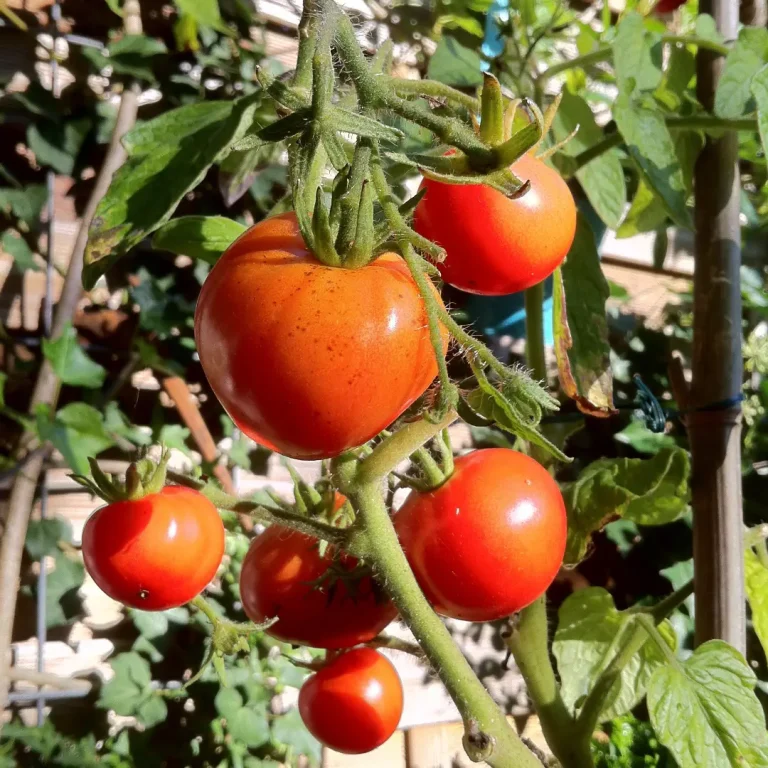Tomatoes are a popular and delicious addition to any home garden. Not only do they taste great, but they offer a range of health benefits too. They contain essential vitamins and minerals and are particularly high in lycopene, an antioxidant that can help to prevent certain types of cancer. If you’re interested in growing tomatoes at home, then this guide contains everything you need to know.
Popular Tomato Varieties
There are many different tomato varieties to choose from, each with their own unique characteristics. Some popular varieties include Moneymaker and Alicante. Moneymaker tomatoes are known for their heavy yields and rich flavour, while Alicante tomatoes are resistant to common tomato diseases and produce lots of juicy fruit.
Other varieties that are worth considering include Roma, San Marzano, and Beefsteak.
San Marzano
Classic, richly flavoured Italian plum tomato which is wholly organic. May also be grown in a tunnel or cool greenhouse. These are much favoured by chefs around the world, and are used use to make tomato paste or a flavoursome sauce, they have fewer seeds, and are fantastic for great pizzas.
Sowing time February-April. Harvest July-September. Plum fruited variety. Deep red skins, meaty flesh and unsurpassable for making sauces!
We keep in stock these great tomato seeds from Mr Fothergill’s and each pack contains 75 seeds.

Growing from Seed
Growing tomatoes from seed is a cost-effective way to get started, and it allows you to choose from a wide variety of different tomato types.
To begin, choose a high-quality seed starting mix and fill several small containers with it. Place one or two seeds in each container and cover them lightly with soil. Water them gently and cover the containers with plastic wrap or a clear dome to create a humid environment.
Keep the containers in a warm, sunny spot and ensure that the soil remains moist. Once the seedlings have developed their first set of leaves, transplant them into larger pots or directly into the ground.
Growing from Tomato Plants
If you’re short on time, then growing tomatoes from pre-grown plants is a great option. Look for plants that are healthy and strong, with thick stems and deep green leaves. Plant them in nutrient-rich soil with a pH level between 6.0 and 6.8, providing plenty of water and sunlight.
When planting your tomato plants, ensure that they are spaced at least 2 feet apart to allow for good air circulation. This helps to prevent the spread of common tomato diseases like blight and powdery mildew.
How To Grow Tomatoes Indoors
Tomatoes can be grown successfully indoors, but it’s important to choose the right variety and provide them with plenty of care and attention. Dwarf tomato varieties like Tiny Tim and Patio are ideal for indoor growing.
They require less space than traditional tomato plants and can be grown in containers. When growing tomatoes indoors, ensure that they receive at least 12 hours of sunlight per day. You can achieve this by placing them in a south-facing window or by using grow lights.
To ensure that your indoor tomato plants receive enough nutrients, fertilise them regularly with a balanced fertiliser. You can also provide them with natural fertilisers like compost tea or worm castings.
Caring For Your Growing Tomatoes
In addition to selecting the right variety and growing method, caring for your tomato plants is crucial for a successful harvest.
Here are some tips to help you care for your growing tomatoes:
- Watering: Tomatoes need consistent moisture to thrive, so ensure that the soil stays moist but not waterlogged. Check the soil moisture daily during hot weather and water deeply once or twice a week, depending on rainfall.
- Fertilising: Tomatoes are heavy feeders and require regular fertilisation to grow strong and produce fruit. Feed your plants with a balanced fertiliser every two weeks during the growing season.
- Pruning: Pruning helps to increase airflow and reduce the risk of disease. Remove the bottom leaves of the plant as it grows taller and pinch off any suckers (small stems) that grow in the crotch between the main stem and a branch.
- Mulching: Mulching helps to retain moisture and regulate soil temperature. Use organic mulch like straw, leaves, or grass clippings, and apply a layer of 2-3 inches around the base of the plant.
- Dealing with pests and diseases: Tomato plants are susceptible to a range of pests and diseases, including aphids, caterpillars, blight, and powdery mildew. Monitor your plants regularly and take action promptly if you notice any signs of pest or disease problems. You can use natural pest control methods like handpicking or spraying with a mixture of soap and water.
By following these tips to care for your growing tomatoes, you can avoid common problems and ensure a healthy and productive crop. Keep an eye on your plants and adjust your care routine as needed to promote strong growth and a bountiful harvest.
Harvesting Your Tomatoes
Once your tomatoes start to ripen, it’s important to harvest them at the right time. Pick them when they are fully ripe but still firm. Avoid leaving them on the vine for too long, as this can lead to over-ripening and split skin.
To pick your tomatoes, gently twist them off the stem or use a pair of scissors to cut them off. If you have an abundance of ripe tomatoes, you can store them in a cool, dry place or make tomato sauce, salsa or other tomato-based recipes.
Alternatively, you can freeze or can them for later use.
In Conclusion
In conclusion, growing tomatoes at home can be a rewarding and enjoyable experience. By choosing the right variety, selecting the best method of growing and providing them with the appropriate care, you can produce a bountiful harvest of delicious and nutritious tomatoes. Whether you’re growing them from seed, pre-grown plants, or indoors, follow these tips to become a successful tomato grower.


